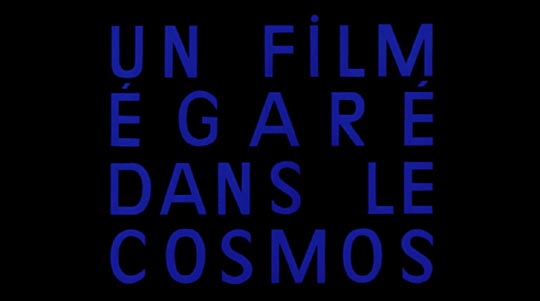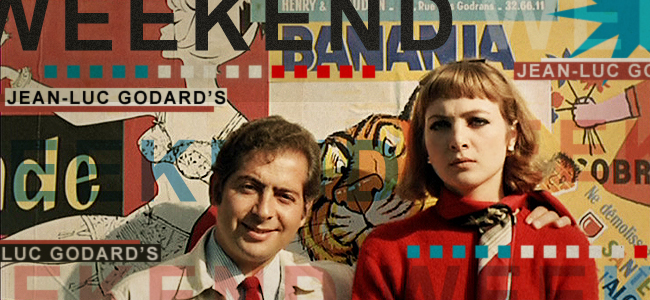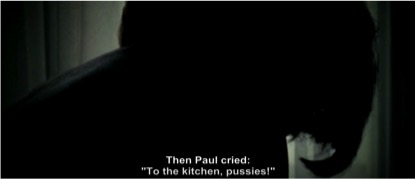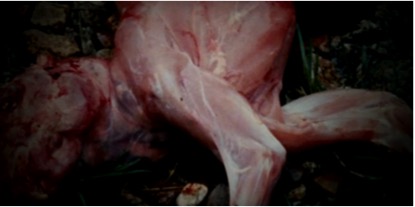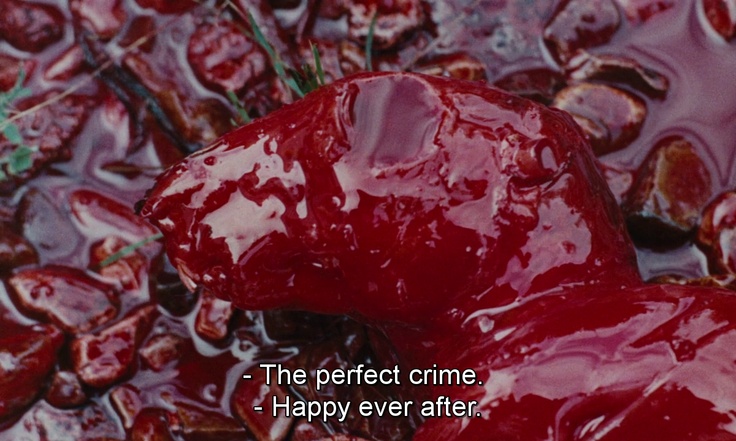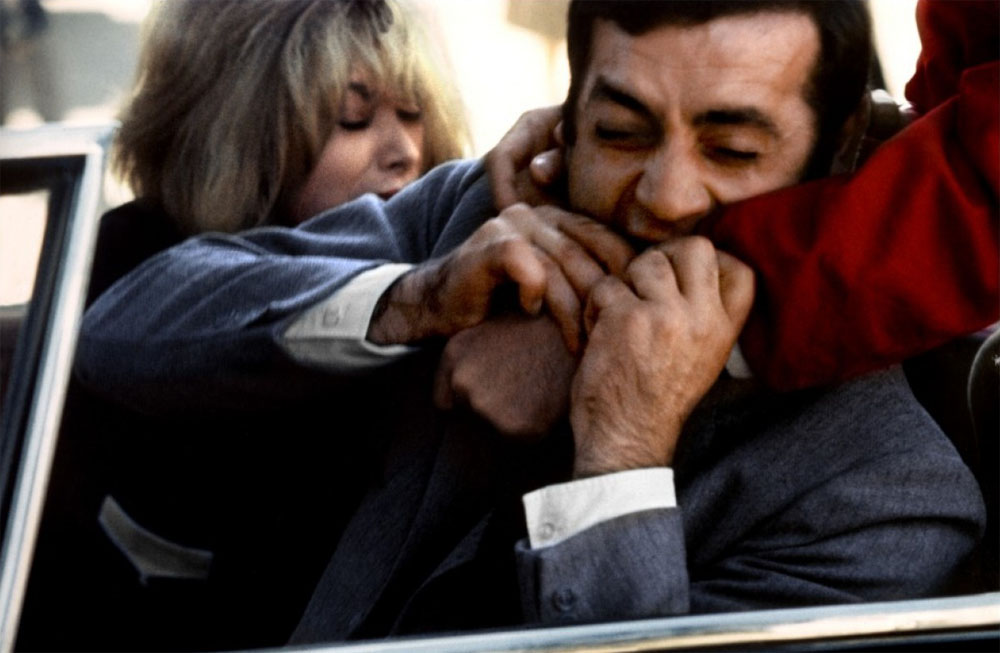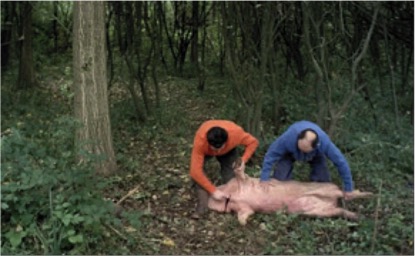Weekend (1967), dir. Jean-Luc Godard (watch the full film with English subtitles here)
Jean-Luc Godard’s 1967 film Weekend follows the distinctly middle-class experience of Roland and Corinne as they take a trip to Corinne’s family home in the country to secure her inheritance from her father, which, as we will find out, they will acquire by any means necessary. Godard’s social commentary tackles what it truly means to be human and, by extension, what it means to be ‘civilised’. Given that Weekend is punctuated by animals both real and referenced – rabbits, a worm, a hippopotamus, tigers, lions and llamas to name but a few – it is possible to introduce animals into a conversation about civilisation that sees the animal as the site at which sex, violence consumerism and food intersect, allowing Godard to highlight the barbarism of a world run by consumer desire.
A scathing black comedy that encompasses the spirit of upheaval that followed in Europe the next year, Godard’s film feeds into a period of New Wave cinema that took social critique to the big screen. Like the pop-art he references in his colourful, repetitive title frames, Weekend goes through a process of ‘absorbing the products and processes of commodity culture, de-familiarizing them through rhythmic repetition and self-referential irony, and transforming then into art objects that are mechanical embodiments of and critical commentaries on the relentlessly productive society from which it emerged’ [1]. The process of dismemberment in the film, used to critique the fetishism of commodity that it is itself part of, is mirrored in a dismemberment of animals that almost seems to critique their commodification, but ultimately falls short in the animal cruelty practiced in film making, as Godard uses (and often exploits) animals to make his point throughout.
Consumerism
Throughout the film it is consumerism, and particularly Godard’s contempt of it, that lies beneath the surface. Nowhere does this become more apparent than when Corinne and Roland, held hostage by a couple hoping to hitch a ride to London, are asked what wishes they would like granted to them in return. Their reply, ‘a big Mercedes sports car? An Yves Saint Laurent dress? A Miami Beach hotel?’ epitomises a lust for the material that is the driving force behind Corinne and Roland’s journey to Oinville, and behind much of Godard’s view of society. Perhaps one of the most characteristic of Godard’s scenes, the traffic jam scene, in which the couple attempt to manoeuvre themselves through the inanimate cars, lorries and bodies that litter the road, the appearance of various caged animals – lions, chimpanzees, a llama – is odd, their docility heightened by the distinctly human chaos that surrounds them. The camera’s steady progression along the long stretch of road makes the paralysis of the cars, coupled with the incessant honking of car horns, all the more uncomfortable; the cars and the humans within them are as trapped as the animals in their cages. David Sterritt suggests that the scene ‘introduces automobiles as the film’s main symbolic objects, embodying the materialism and aggression of a society being crushed by its own fetishized commodities’ [2]. It is true, cars in Weekend exist as a symbol of both physical and metaphorical entrapment, and yet it is through a coupling of this idea with the use of animals, themselves a ‘fetishised commodity’, that gives light to Godard’s vision of civilisation.
The image of the cage is echoed by the image of the ‘Man in the Phone Booth’, played by Jean-Pierre Leaud (who we see just moments earlier walking through a field preaching the inconsistency of humanity), who serves as a bizarre reminder of our need to be heard, as he performs a song (‘Here in the photo booth I’m cooped up for all to see’) and becomes increasingly panicked at not being heard (‘Hello, can you hear me? Reply, are your lips too slack?’). The scene mirrors the animals we see in the traffic jam scene, who are physically trapped and unable to be heard over the bourgeois dystopia that surrounds them. Both the animals and the Man in the Phone Booth are used in the pursuit of money, and in various ways. The lions and chimpanzees are used for spectacle as they are taken to the circus or the zoo, the llama for the use of its fur, the horse for its labour and the man for his car, which Corinne and Roland steal in the pursuit of Corinne’s inheritance money. Their physical entrapment (the animals in their cages and the man in the phone booth, as well as the people trapped in their cars we see previously) serves to symbolise the shackles of the consumerist society Godard satirises.
Sex
Corinne’s description of a sex act involving the use of animal products at the beginning of the film brings animals into a discourse of sex and gender that is, as Carol J. Adams’s The Sexual Politics of Meat can highlight, bound up in speciesism and sexism. Paul, a third of the threesome Corinne describes to Roland, directs the scene as he cries: ‘to the kitchen, pussies!’
The double meaning of ‘pussy’ here, part of what Adams calls an ‘absent referent’ that follows a process of renaming that both animals and women are subject to (‘animals are the absent referent in the act of meat eating; they also become the absent referent in images of women butchered, fragmented, or consumable’ [3]) renders the women as not only dismembered, referred to by their ‘consumable’ body parts, but ‘consumable’ themselves, much like the milk and eggs they use in foreplay. This plays into the wider discourse present throughout Godard’s film that explores commodity fetishism as the product of consumerist society, bringing Marxism and feminism in line with animal studies. Furthermore, the use of eggs and milk in acts of a sexual nature instead of for what they are culturally intended (consumption/food) points to the kind of middle class excess Godard critiques and Roland, Corinne, Paul and Monique come to represent.
Violence
‘Animals are made absent through language that renames dead bodies before consumers participate in eating them. Our culture further mystifies the term “meat” with gastronomic language, so we do not conjure dead, butchered animals, but cuisine.’ [4]
Carol J. Adams
The camera fixes on the image of the skinned rabbit, as Corinne and Roland murder Corinne’s mother out of shot. This adds to the wider distancing from violence that occurs throughout the film, as the act of murder is heard but not seen. Using the image of a dead rabbit as a somehow less violent exposes a hierarchy that values human bodies over animals
In Weekend, violence is everywhere. Bodies litter almost every scene, and Roland and Corinne’s comic refusal to acknowledge them mirrors an odd process of desentitisation we go through as audience. Throughout, Godard comments on the ease with which we can ignore the pain of others, and especially how this becomes a product of a preoccupation with material things (Corinne’s outburst of ‘My Hermès bag!’ as a group of cars explode exemplifies this). The presence of butchered animals, too, is something that adds to the overall chaos and collateral damage of the film. In this way, Godard subverts what Adams sees as a mystification around meat that sees it as cuisine, because he shows the gruesome image of ‘dead, butchered animal’ (the rabbit, pictured above, and the pig that gets slaughtered later on) as opposed to its ‘meat’ product. Despite this, however, the treatment of animal and human bodies as equal could not be further from the truth in Weekend. Godard exploits animals in two ways: physically, in the actual slaughter of the pig, and metaphorically, in the essential acceptance of animal cruelty to further a dialogue that sees Roland and Corinne as somehow ‘animalistic’. In their analysis of Silence of the Lambs, Cary Wolfe and Jonathan Elmer explain the usefulness of a narrative that sees ‘animalistic humans’ as somehow subhuman (thus meaning the audience are permitted to want to see them hurt in some way), and this reasoning can be extended to Weekend, which also ‘takes for granted the fundamental sacrifice of nonhuman animals (in what we eat, what we wear, the testing of the products we buy), which must continue to be legitimized if the ideological work of marking human Others as animals for the purposes of their objectification and sacrifice to be effective’ [5]. Therefore, the sacrifice of Roland at the end of the film seems legitimised through Godard’s condemnation of him as ‘animal’ all the way through, as his animal behaviours (bearing his teeth, biting) put him in line with the pig, who is similarly sacrificed for the purpose of consumption. Although Godard condemns the type of consumerism that renders animals as meat/fashion/entertainment, he must legitimise these practices and physically condones it in the actual killing of the pig and rabbit for the sake of his own film, which is itself a commodity. The animals of the film must be kept as distinctly nonhuman (as in, still used for labour/meat/leather e.g. Corinne’s Hermès bag) in order for Godard to make a comment on Roland and Corinne’s barbarity and uncivilised behaviour.
Food/Cannibalism
The film reaches is violent, climactic end in the capture of Roland and Corinne by the Seine and Oise Liberation Front, a group of Maoist hippies with a penchant for cannibalism. This display of barbarism ends in Corinne eating the meat of her recently butchered husband, and despite knowing such, asking for more. Godard could, here, be making a point about our desensitisation to the cultural act of meat eating, as the human becomes the ‘absent referent’ for the cooked meat. However, as previously discussed, the scene in which a pig’s throat is slit has been reported as real violence towards the animal, and thus it is impossible to see Godard’s film as a legitimate criticism of all the wrongs of commodity fetishism. Through the use of Corinne’s question ‘when did civilization begin?’, what Godard seems to ask is where does civilization end, and barbarism begin? His subversive style and shocking footage asks the audience: where in the film does the behaviour become unacceptable? Is it in Corinne and Roland’s corrupt morality, seen from the very start? Is it their blatant disregard for the horrors around them? Is it the murder of Corinne’s mother? Or is it in the eating of human flesh?
From caged animals to slaughtered pigs, the animals in Weekend are a means by which the barbarism of its human characters can be illuminated. They are caged in order to make a point about the entrapments of capitalism; their products are used during sexual acts to comment on the excessive behaviour of the middle classes; they are slaughtered to highlight moments of barbarity; and they are eaten with human meat in a shocking act of cannibalism. Despite showing a warts-and-all image of animal bodies that resists Carol J. Adams’s belief that animal bodies are packaged and mystified by language like ‘meat’, the different ways in which animal and human violence is treated in the film is revealing. The most shocking acts of violence towards humans in the film – the murder of Corinne’s mother and the butchering of Roland to be put into stew – take place off-camera, rendered too horrific for audience eyes. What remain instead, however, are violent images of dismembered animal bodies that are somehow deemed more ‘acceptable’. This points to a hierarchy that sees the butchering of animal bodies as culturally expected, but rarely seen. Godard goes some of the way in showing this reality of animal cruelty, but falls short in his exploitation of animals in filming and his refusal to treat animals as examples of the fetishised commodities he criticises. He ultimately must legitimise a discourse of animals as commodity in order to further his narrative of Roland and Corinne as animalistic, and in doing so legitimises animal cruelty for the sake of Weekend, in itself part of the commodity industry.
Like all of Godard’s characteristically avant-garde style, the representation of animals in Weekend is far from conventional. Where his radicalism fails, however, is in the treatment of animals as anything other than vessels that allow him to make a wider point about the human condition, with animal casualties being an inevitable side effect.
Bibliography
Adams, Carol J, The Sexual Politics of Meat: A Feminist-Vegetarian Critical Theory, 10th edn (Oxford, Eng.: Polity Press, 1990)
Weekend, dir. by Jean-Luc Godard (Athos Films, 1967) [Film]
Sterritt, David and Raymond Carney, The films of Jean-Luc Godard: Seeing the invisible (Cambridge: Cambridge University Press., 1999)
Wolfe, Cary and Jonathan Elmer, ‘Subject to Sacrifice: Ideology, Psychoanalysis, and the Discourse of Species in Jonathan Demme’s Silence of the Lambs’, boundary 2, iii, 22 (1995)
[1] David Sterritt and Raymond Carney, The films of Jean-Luc Godard: Seeing the invisible (Cambridge: Cambridge University Press, 1999), p.90.
[2] David Sterritt and Raymond Carney, The films of Jean-Luc Godard: Seeing the invisible (Cambridge: Cambridge University Press, 1999), p.93.
[3] Carol J Adams, The Sexual Politics of Meat: A Feminist-Vegetarian Critical Theory, 10th edn (Oxford, Eng.: Polity Press, 1990), p.13
[4] Carol J Adams, The Sexual Politics of Meat: A Feminist-Vegetarian Critical Theory, 10th edn (Oxford, Eng.: Polity Press, 1990), p.66
[5] Cary Wolfe and Jonathan Elmer, Subject to Sacrifice: Ideology, Psychoanalysis, and the Discourse of Species in Jonathan Demme’s Silence of the Lambs, p.146
